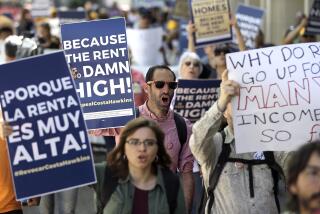Santa Monica Landlords Assail Conclusions : Poll Says City Hasn’t Gone Yuppie
- Share via
The Great Yuppie Debate is on again in Santa Monica.
The city’s Rent Control Board says a new survey it commissioned shows that rent control has not spawned “Yuppie-fication” of the city.
However, landlords immediately challenged the survey, saying both it and the conclusions drawn from it are flawed.
They argue that rent control has primarily benefitted wealthier, younger and mainly white tenants who they say are pouring into Santa Monica and displacing low-income residents and families.
The demographic survey, conducted by the Los Angeles-based Planning Group in May and June, was made public last week and fueled anew the debate in a city where one of the nation’s strongest rent control laws has been in force for eight years.
The study said that the income distribution of Santa Monicans has not changed substantially since rent control went into effect in 1979 and that the proportion of low-income renters has held fairly stable.
However, it also shows the number of blacks and Latinos has declined, while it says there are more elderly and fewer children than expected.
“There has not been income gentrification,” the displacing of low-income tenants by wealthier tenants, said Eugene Grigsby, one of the consultants who wrote the survey. But he said the results “allude” to discrimination.
“Because of the total tightness of the housing market, landlords tend to chose who they want,” Grigsby said. “All things being equal, among a black, a Hispanic, a white, who would you take? It would appear (landlords) took more whites.”
Grigsby added the survey showed that a “friendship network” has emerged through which aspiring tenants find out about and get rentals in Santa Monica. He said blacks and Latinos are less likely to be plugged into that network.
He cautioned that small sample sizes make it impossible to draw broad conclusions on why there are fewer blacks and Latinos.
The survey labelled the decline in blacks and Latinos dramatic. It said the two groups accounted for 22.9% of the city population in 1979 and only 16.4% now.
In other findings, the study said that 71.4% of Santa Monica’s tenants moved into the city since rent control began in April, 1979, but at the same time the average length of a tenant’s stay has increased by a little more than two years.
The percentage of renters saying the condition of their apartment is poor or very poor has more than doubled to 13.6%. The majority still perceives the condition of apartments as good or very good, 61%, down from 68.1% in 1979-80.
Fewer Disputes
The survey, conducted by telephone and involving 411 households, also said that disputes between landlords and tenants have declined. It put the average monthly savings in rent due to rent control at $160.
Susan Davis, who chairs the Rent Control Board, praised the survey as “incredibly encouraging . . . very heartening . . . wonderful.”
“It shows there has been very little change, no gentrification,” Davis said to scattered applause during the annual convention of Santa Monicans for Renters’ Rights earlier this week. “Most arguments (used by landlords) proved fallacious.”
Landlords called the survey preposterous. Their reading of it produced opposite conclusions.
“They (the Rent Control Board) obviously looked at the results (of the survey) through ideologically biased sunglasses,” said James Baker, a landlord spokesman and owner of four apartment buildings in Santa Monica.
“It is clear there are major changes under way in Santa Monica which the report glosses over or refuses to recognize,” he said. “The report is a confirmation of gentrification, and that it (gentrification) is accelerating.”
The survey found the low number of children surprising. However, opponents of rent control have argued for some time that landlords are less likely to rent to families with children and prefer single tenants because of less wear and tear on apartments.
“Securing Santa Monica bargains has become a game for aggressive, single, high-income, articulate white people,” Baker said. “That is who is skilled in this game.”
More to Read
Sign up for Essential California
The most important California stories and recommendations in your inbox every morning.
You may occasionally receive promotional content from the Los Angeles Times.














